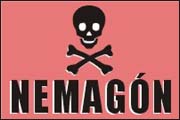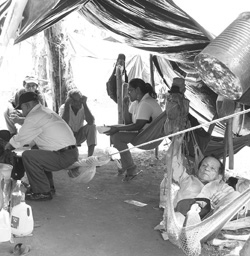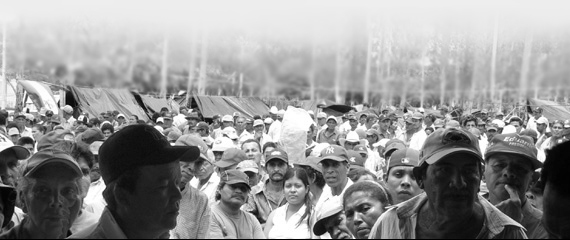|
 |
Study finds residues of this poison
in Chinandega wells |
|
Many years after the agrotoxic substance DBCP -or simply
Nemagon- stopped being used, the cause of the misery
suffered by thousands of Nicaraguans is still very much
alive in Chinandega. A newly released scientific study
by the UNAN has found traces of the poison in 15 wells
of Chinandega, which are a source of drinking water. The
beast lives. And it lives not only in the minds and
bloodstreams of those who knew it and lived with it in
the banana plantations. Now it lies hidden, and
diminished, in the water wells that the rural
inhabitants of Chinandega use for daily consumption.
A scientific study conducted over a period spanning from
the first half of 2006 through May 2007, by the Center
for Research on Nicaraguan Aquatic Resources (CIRA)
of the National Autonomous University of Nicaragua (UNAN),
in banana production regions of the 1970s and 80s,
revealed the existence of residues of DBCP and ten other
pesticides used in cotton and banana crops.
The title of this study is “Presence and concentration
of pesticide residues and biological contaminants in the
water of wells used for human consumption in localities
of former banana plantations in the Western region of
Nicaragua”, and the head researchers were the
specialists Salvador Montenegro Guillén and
Mario Jiménez García.
As indicated in the summary of the full report, the
scientists measured the physical, chemical and
microbiological quality of the water and performed
toxicology assessments to determine if there were
organochlorine pesticide residues in the water of 15
hand-dug wells that have been supplying water to rural
populations of the department of Chinandega for the past
38 years or less.
100% Nemagón
“Los resultados analíticos muestran presencia de
residuos de plaguicidas empleados en el cultivo del
algodón y banano. El residuo del Dibromo-Cloro-Propano
(DBCP), Nemagón o Fumazone por sus
nombres comerciales, se encontró en todos los pozos
muestreados, en bajas concentraciones”, dice el informe,
donde se lee la presencia de al menos once sustancias
tóxicas más, entre las cuales se mencionan el
hexaclorobenceno, beta benzenehexaclorido, heptacloro,
heptacloro epoxido, dieldrin, endrin, DDE, DDD, DDT y
toxafeno.
Chinandega
was for several decades an agricultural production
paradise, and it was bombarded with tons of chemicals
used to kill and control pests in banana and cotton
crops. Years after the agricultural production boom of
these plantations had ended, thousands of peasants,
former laborers in these crops, began reporting serious
illnesses.
Nearly eight thousand of these peasants, former laborers
of the banana haciendas, have claimed to be victims of
the harmful effects of DBCP, which was marketed in
Chinandega under the commercial names Nemagon and
Fumazone.
At least 2000 of them have died and another thousand are
ill, according to data from the Association of Workers
and Former Workers Affected by Nemagon (Asotraexdan).
For this study, and with the help of former workers of
the banana plantations, the researchers identified ten
hand-dug wells, which are still being used as sources of
drinking water, located in the area of the old banana
plantations in the department of Chinandega, in
particular in the west and northwest areas of the El
Viejo municipality.
On top of the poison, feces
Five wells that have been in use for the last five to 38
years, located in east Chinandega, in the region
of La Mora -some two kilometers southeast of the
city, where there were no banana crops-, were selected
to compare water quality.
According to the research report, semipermeable membrane
devices (SPMD) were used as passive samplers in each of
the selected wells. These samplers, which can capture
small concentrations of residues, were placed in March
2006 and removed in April of that year, at which time
water samples were also taken to perform the general
physical and chemical analysis and the microbiological
analysis.
Small quantities of DBCP were found in the waters
of all the wells studied, both those located in the
surrounding areas of the banana plantations and those
used for comparison control purposes.
The Nemagon residues found were in amounts below
the compound’s maximum contaminant level, but that was
not the case for bacteria, as high levels of
contamination from human and animal feces were detected
in the water consumed in the researched area of
Chinandega.
Deadly cocktail
“Of the eleven pesticides detected, the most frequently
found was DBCP, identified in 100% of the wells
studied, followed by pp-DDE, found in eight wells
(66.6%), Dieldrin, in seven wells, and pp-DDT,
in four wells, while Eldrin and pp-DDD
were both found in two wells, and BHC,
Heptachlor, Heptachlor Epoxide, and
Toxaphene were each found in a different well,” the
study indicates, and again notes that the levels found
apparently pose no risks to human health, but at the
same time warns that the possibility of risks cannot be
ruled out.
|
The study also points out that the chronic effects of
DBCP on human health may potentially lead to kidney
damage and sterility in cases of long term exposure,
specially at high |
|
“In general terms, it should be noted that while most of
these organochlorine pesticides registered low Maximum
Contaminant Levels, the possible synergic effect of
these residues -what’s known as the cocktail effect-
cannot be ruled out, as the combined action of these
compounds puts inhabitants at a greater cumulative risk
of suffering pathologies connected with chronic exposure
to these xenobiotics,” the report cautions.
The study also states that the presence of high
concentrations of bacteria, indicating human and animal
fecal contamination, determines that the waters studied
are unfit for human consumption, and pose a serious
health risk.
“The fact that DBCP was found in small amounts
today evidences that it was used in Western Nicaragua
and has contaminated the groundwater table, given its
presence in the wells studied,” the document continues,
explaining that due to its low rate of hydrolysis,
BDCP can remain up to 141 years in
groundwater.
A century to clean out the poison
“As the use of this compound dates back some
40 years, we still have one more century to go before it
is fully eliminated through its own process of
decomposition,” the research sentences.
The study also points out that the chronic effects of
DBCP on human health may potentially lead to kidney
damage and sterility in cases of long term exposure,
specially at high levels.
“The International Agency for Research on Cancer
classifies DBCP as a probable human carcinogen,
including it in Group 2B of carcinogenic substances,”
the scientific report informs, indicating that this is
the first study that measures DBCP content in
Nicaragua’s groundwater. And the first study that
detects it.
“Maybe now they’ll believe us”
The existence of a study that determines the presence of
the chemical DBCP, a compound of the pesticide
known as Nemagon, caused shock and alarm among
the more than two thousand peasants that are camping out
in front of the National Assembly demanding social
benefits.
Last Thursday, Victorino Espinales, a leader of
the Nemagon victims, called other peasant leaders
to an urgent meeting to explain the scope of the
CIRA-UNAN research study.
|

Campamento de Afectados por NEMAGÓN |
“This confirms that Nemagon is not just in the
bloodstreams of those of us who worked in the
plantations; and it also proves that the poison is still
alive and contaminating the new generations that drink
the water from those wells,” Espinales said.
He also announced that they would be holding a full-day
rally to protest peacefully and demand that the Ministry
of Health come to Chinandega and that the
government adopt health measures in the researched area.
For his part, Manuel Hernández, another leader,
who is originally from the municipality of Posoltega,
Chinandega, called on the country’s health
authorities to declare a state of emergency in the area
where the chemical was detected, and order a
comprehensive study to assess the situation of other
wells in the area.
“We thought the Nemagon nightmare had ended with
our illnesses, but now we see that the devil is alive
and kicking. I ask the Ministry of Health to conduct a
thorough investigation, because it’s appalling that
after all these years our people are still being
condemned to die, poisoned by Nemagon,” he demanded.
Forensic Medicine confirms
Similarly, the peasant leader Daysi Ambota, also
present in the meeting convened to discuss the CIRA
report, called on health authorities and academic
institutions to thoroughly corroborate the CIRA’s
findings, as for her, “the silent presence
Nemagon in the water that the people of Chinandega drink
daily is a serious matter.”
The study conducted by the expert Salvador Montenegro
and by several other specialists reveals the presence
of DBCP and ten other chemical substances in
nine wells selected randomly in the areas where banana
was grown in the 1970s and 80s.
It should be noted that the project was supported
financially by the National Council of Universities,
with funds from donors and the CIRA itself.
Laboratory analysis specialists were also involved, and
tests were performed in the microbiology, natural water
and radiochemistry, environmental, and organic
contaminant laboratories of the CIRA.
The laboratory of the Forensic Medicine Institute of the
Supreme Court of Justice confirmed the results of the
analysis that detected DBCP in the water, using
mass spectroscopy.
José Adán Silva
Nuevo Diario
(Nicaragua)
August 17, 2007

Fotos: Giorgio Trucchi
artículos
relacionados
Volver
a Portada
|
UITA - Secretaría Regional
Latinoamericana - Montevideo - Uruguay
Wilson
Ferreira Aldunate 1229 / 201 - Tel. (598 2) 900 7473 - 902 1048 -
Fax 903 0905
|